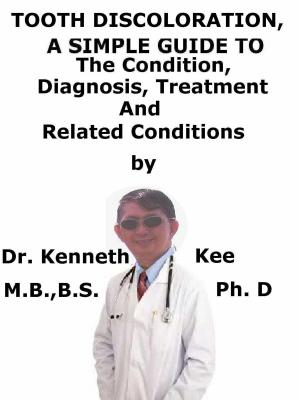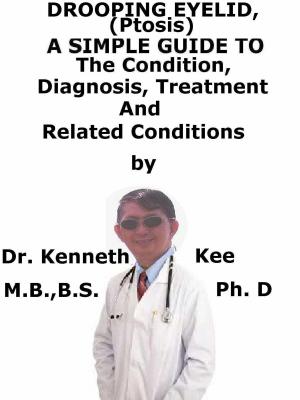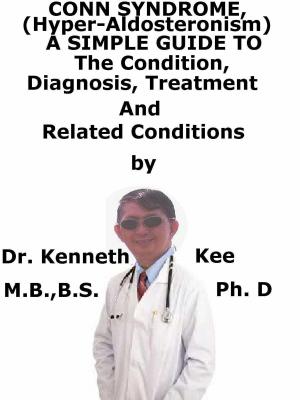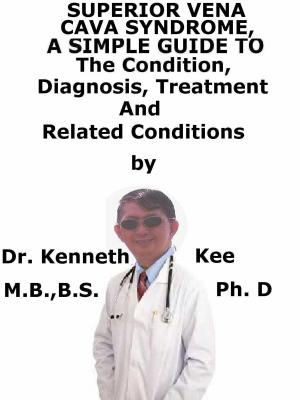Behcet’s Disease A Simple Guide To The Condition, Diagnosis, Treatment And Related Conditions
Nonfiction, Health & Well Being, Medical, Medical Science, Immunology, Health, Ailments & Diseases, Immune System| Author: | Kenneth Kee | ISBN: | 9781370640119 |
| Publisher: | Kenneth Kee | Publication: | February 15, 2018 |
| Imprint: | Smashwords Edition | Language: | English |
| Author: | Kenneth Kee |
| ISBN: | 9781370640119 |
| Publisher: | Kenneth Kee |
| Publication: | February 15, 2018 |
| Imprint: | Smashwords Edition |
| Language: | English |
This book describes Behcet’s Disease, Diagnosis and Treatment and Related Diseases
Behcet's disease (also known as Behcet's syndrome) is an infrequent disorder which causes frequent ulcers in the mouth and genital area and can affect different parts of the body.
The syndrome most often affects the eyes (ileitis), mouth (pathos ulcers) and skin (genital sores).
Behcet's disease is a disease that involves vasculities (inflammation of the blood vessels).
It causes disorders in many parts of the body.
Causes
The actual cause of this disorder is still not entirely understood, even though there is plenty of research being done in this area.
Most symptoms of Behcet’s disease are due to swelling of the blood vessels.
The patient may have a gene that causes a disorder in the immune system, making it more likely the person will get the disease.
Some item in the environment, such as bacteria or viruses, may then cause the immune system to attack its blood vessels.
Symptoms:
The symptoms of Behcet’s disease differ for each person.
Some people have only mild symptoms, such as sores in the mouth.
Others have more serious disorders, such as vision loss.
If the person is having symptoms, then he or she is going through a “flare.”
The five most frequent symptoms of Behcet’s disease are:
1.Mouth sores.
2.Genital sores.
3.Other skin sores.
4.Swelling of parts of the eye.
5.Arthritis (pain, swelling, and stiffness in the joints).
Less frequent symptoms are:
1.Swelling in the brain and spinal cord.
2.Blood clots.
3.Swelling in the digestive system (the parts of the body that digest food).
4.Blindness.
Diagnosis:
Behcet’s disease is hard to diagnose because:
1.The symptoms do not normally appear all at once.
2.There are other illnesses that have the same symptoms.
3.There is no single test to diagnose Behcet’s disease.
Symptoms used to find out if the person has the disease are:
1.Mouth sores at least three times in 12 months.
2.Two of the following:
a.Genital sores that go away and come back.
b.Swelling of parts of the eye (with vision loss).
c.Skin sores.
d.Small red bumps that occur after the doctor pricks the skin with a needle.
The pathergy test, which measures the sensitivity of the skin, may be done by the doctor.
If a typical diagnostic red spot appears, the result is positive.
If the result is positive this does not mean that the patient definitely does have Behcet's disease.
Treatment
There is no cure for Behcet’s disease.
The treatment will help decrease pain and prevent serious disorders.
Medicines:
1.Corticosteroids—medicines to reduce pain and swelling.
2.Other drugs to help control the immune system, decrease swelling, and prevent symptoms.
Activity
1.Rest when having symptoms.
2.Moderate exercise, such as swimming or walking
If the symptoms are mild then the patient may only need treatment such as topical steroid to mouth ulcers when he or she has a flare-up.
Steroid eye drops are given if the patient has inflammation of the middle layer of the eye (uveitis).
Simple painkillers such as paracetamol or ibuprofen may improve any painful joints.
If the patient is experiencing more severe symptoms then medicine is normally given to try to suppress the disease.
This is normally in the form of steroid tablets and also another medicine to suppress the immune system
For oral and genital ulcers, the topical steroids or sucralfate solution is the first-line treatment for mild isolated ulcers.
For serious mucocutaneous sores, systemic corticosteroids, azathioprine, dapsone, interferon-alfa, colchicine, and thalidomide have improved
Doctors advise using infliximab and adalimumab as first-line immunomodulatory medicines for eye manifestations
TABLE OF CONTENT
Introduction
Chapter 1 Behcet’s Disease
Chapter 2 Causes
Chapter 3 Symptoms
Chapter 4 Diagnosis
Chapter 5 Treatment
Chapter 6 Prognosis
Chapter 7 Stomatitis
Chapter 8 Aphthous Mouth Ulcers
Epilogue
This book describes Behcet’s Disease, Diagnosis and Treatment and Related Diseases
Behcet's disease (also known as Behcet's syndrome) is an infrequent disorder which causes frequent ulcers in the mouth and genital area and can affect different parts of the body.
The syndrome most often affects the eyes (ileitis), mouth (pathos ulcers) and skin (genital sores).
Behcet's disease is a disease that involves vasculities (inflammation of the blood vessels).
It causes disorders in many parts of the body.
Causes
The actual cause of this disorder is still not entirely understood, even though there is plenty of research being done in this area.
Most symptoms of Behcet’s disease are due to swelling of the blood vessels.
The patient may have a gene that causes a disorder in the immune system, making it more likely the person will get the disease.
Some item in the environment, such as bacteria or viruses, may then cause the immune system to attack its blood vessels.
Symptoms:
The symptoms of Behcet’s disease differ for each person.
Some people have only mild symptoms, such as sores in the mouth.
Others have more serious disorders, such as vision loss.
If the person is having symptoms, then he or she is going through a “flare.”
The five most frequent symptoms of Behcet’s disease are:
1.Mouth sores.
2.Genital sores.
3.Other skin sores.
4.Swelling of parts of the eye.
5.Arthritis (pain, swelling, and stiffness in the joints).
Less frequent symptoms are:
1.Swelling in the brain and spinal cord.
2.Blood clots.
3.Swelling in the digestive system (the parts of the body that digest food).
4.Blindness.
Diagnosis:
Behcet’s disease is hard to diagnose because:
1.The symptoms do not normally appear all at once.
2.There are other illnesses that have the same symptoms.
3.There is no single test to diagnose Behcet’s disease.
Symptoms used to find out if the person has the disease are:
1.Mouth sores at least three times in 12 months.
2.Two of the following:
a.Genital sores that go away and come back.
b.Swelling of parts of the eye (with vision loss).
c.Skin sores.
d.Small red bumps that occur after the doctor pricks the skin with a needle.
The pathergy test, which measures the sensitivity of the skin, may be done by the doctor.
If a typical diagnostic red spot appears, the result is positive.
If the result is positive this does not mean that the patient definitely does have Behcet's disease.
Treatment
There is no cure for Behcet’s disease.
The treatment will help decrease pain and prevent serious disorders.
Medicines:
1.Corticosteroids—medicines to reduce pain and swelling.
2.Other drugs to help control the immune system, decrease swelling, and prevent symptoms.
Activity
1.Rest when having symptoms.
2.Moderate exercise, such as swimming or walking
If the symptoms are mild then the patient may only need treatment such as topical steroid to mouth ulcers when he or she has a flare-up.
Steroid eye drops are given if the patient has inflammation of the middle layer of the eye (uveitis).
Simple painkillers such as paracetamol or ibuprofen may improve any painful joints.
If the patient is experiencing more severe symptoms then medicine is normally given to try to suppress the disease.
This is normally in the form of steroid tablets and also another medicine to suppress the immune system
For oral and genital ulcers, the topical steroids or sucralfate solution is the first-line treatment for mild isolated ulcers.
For serious mucocutaneous sores, systemic corticosteroids, azathioprine, dapsone, interferon-alfa, colchicine, and thalidomide have improved
Doctors advise using infliximab and adalimumab as first-line immunomodulatory medicines for eye manifestations
TABLE OF CONTENT
Introduction
Chapter 1 Behcet’s Disease
Chapter 2 Causes
Chapter 3 Symptoms
Chapter 4 Diagnosis
Chapter 5 Treatment
Chapter 6 Prognosis
Chapter 7 Stomatitis
Chapter 8 Aphthous Mouth Ulcers
Epilogue















